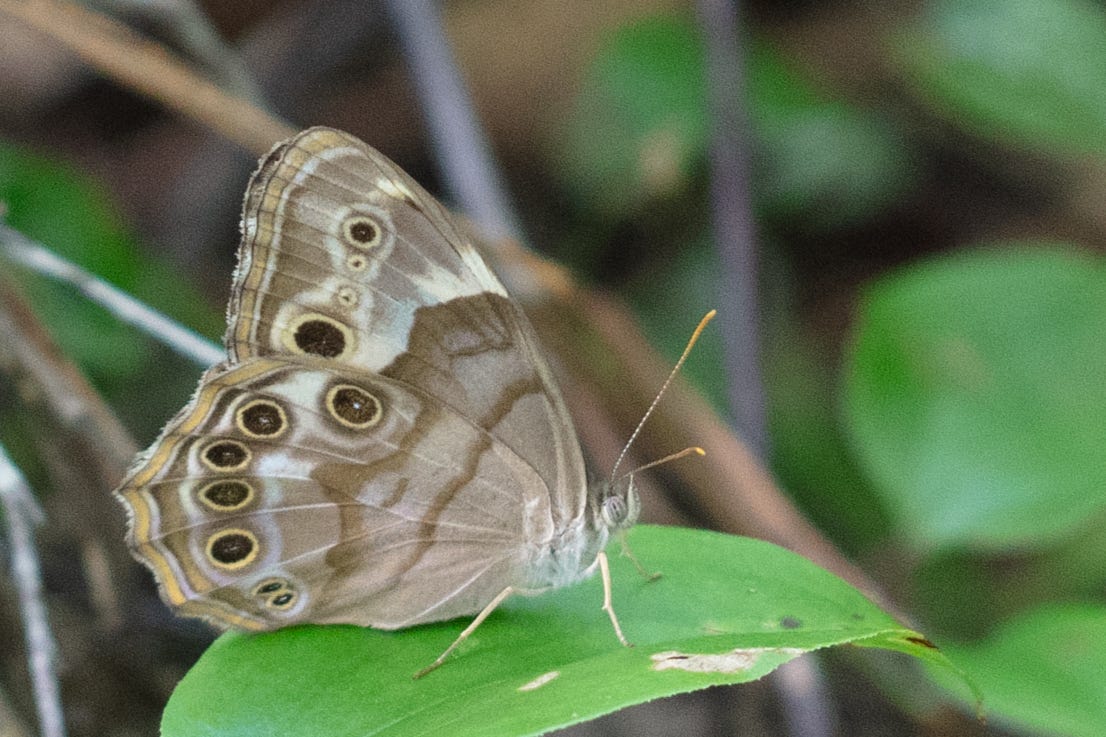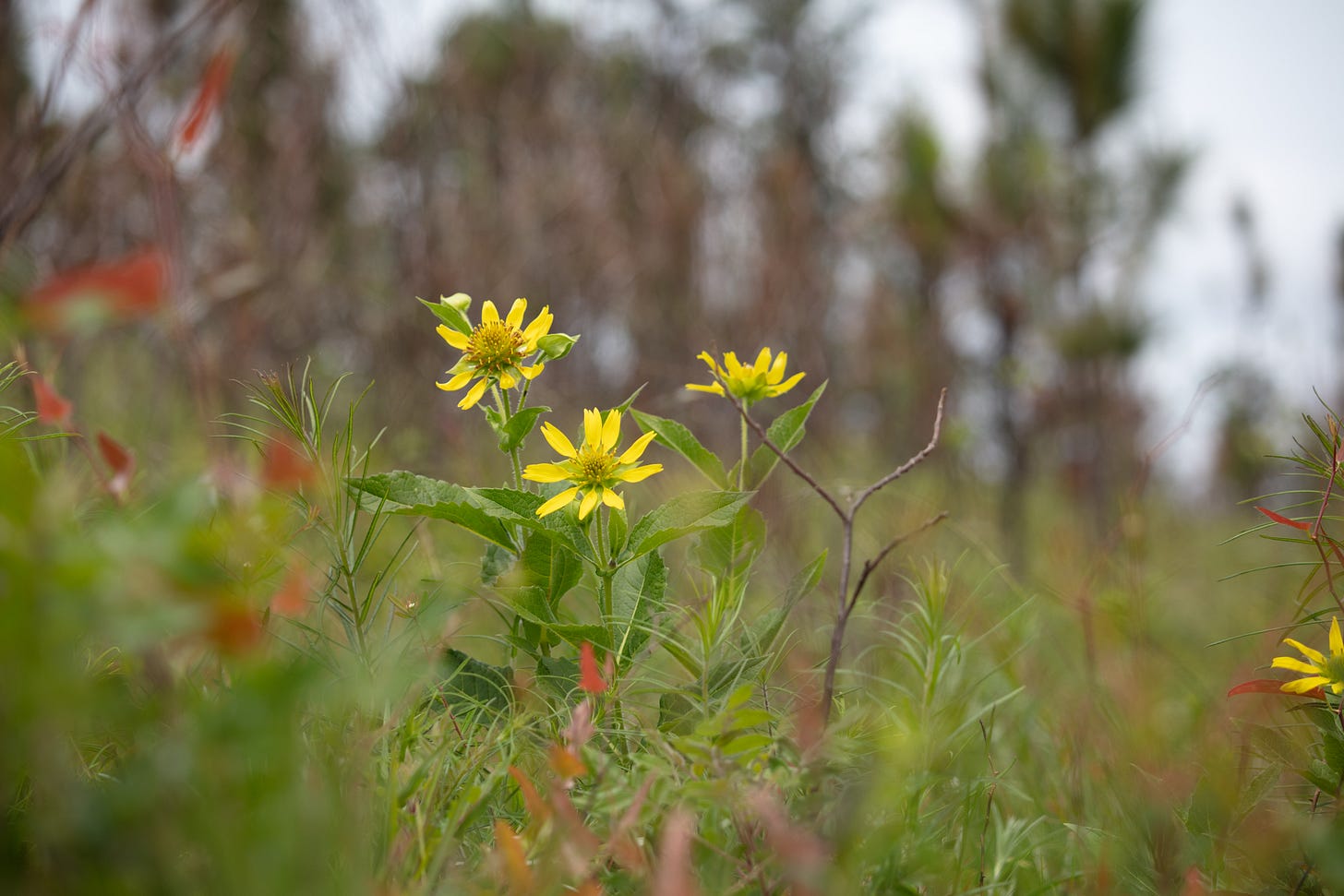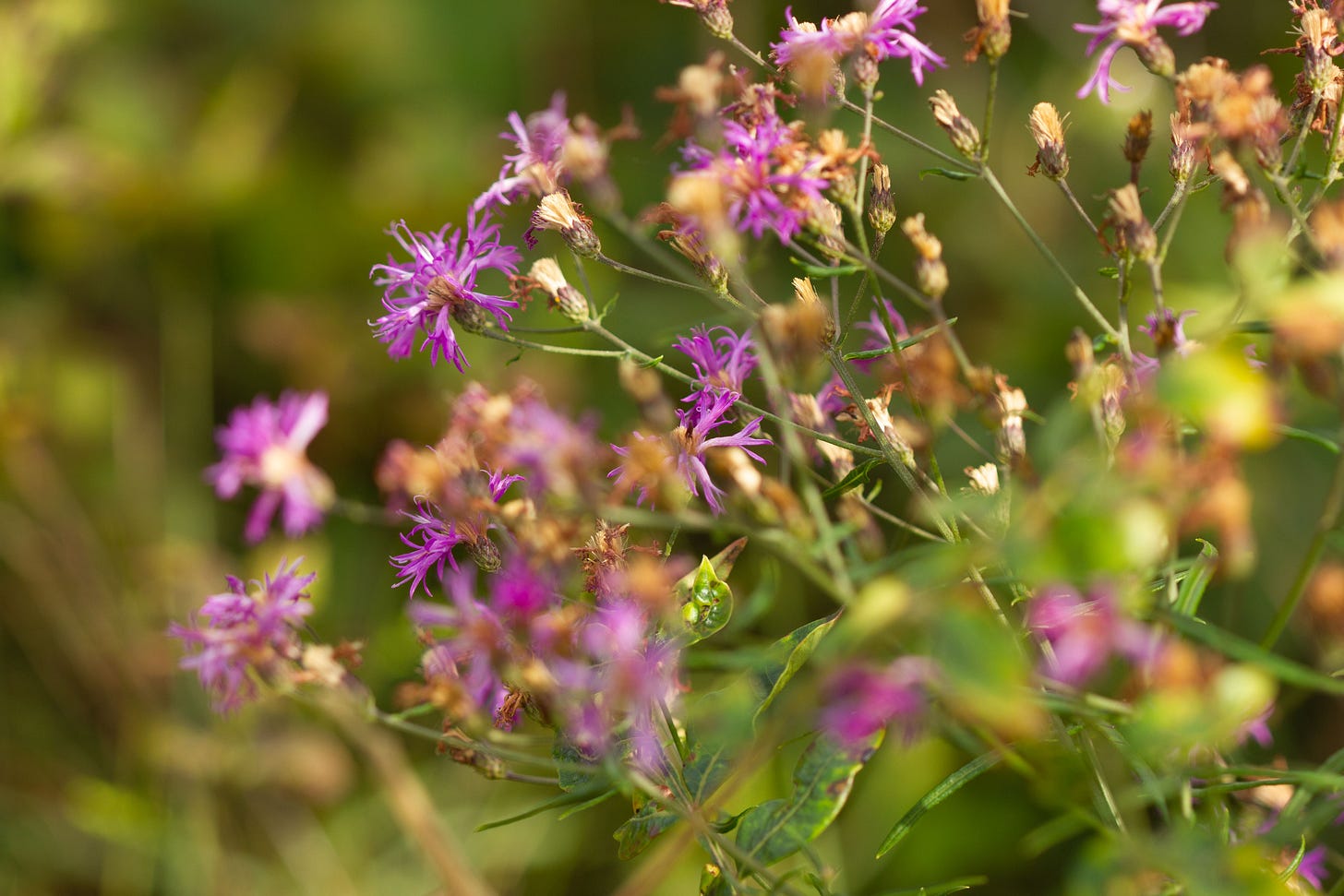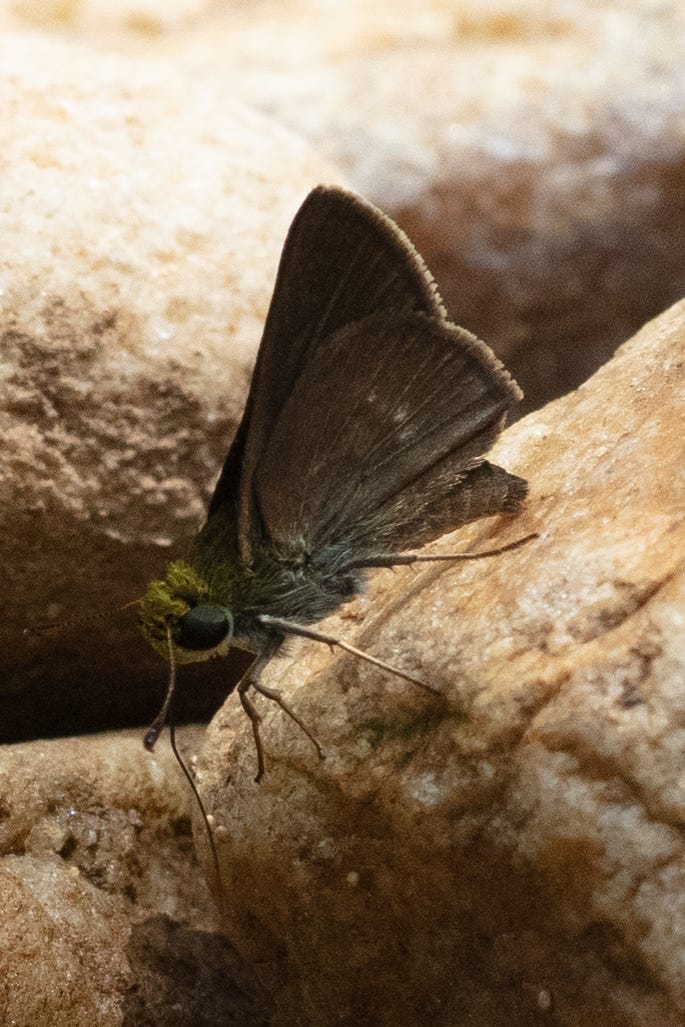
An in-between place in an in-between place, the Pine Mountain Ridges emerge from the Georgia Piedmont, forming a small mountain range distinct from and between the Appalachian Mountains of North Georgia and the flat Coastal Plain to the South. Here the flora of all three regions — the North Georgia mountains, the South Georgia Coastal Plain, and the Georgia Piedmont —grow together. On these mountains, one can find mountain laurel, swamp titi, Georgia oak, and montane longleaf pine.
Hollis quartzite, a very hard, erosion-resistant rock that breaks in almost cube-shaped blocks, comprises much of these mountains. It forms scenic landscapes, such as Sprewell Bluff, where the Flint River flows. It also forms rocks with blunt corners that poke uncomfortably through the soles of hiking boots on the Pine Mountain Trail.
Wide and blue, the Flint River cuts through Sprewell Bluff Wildlife Management Area, its flow interrupted by rocky shoals. Near its western shores, patches of water-willow (Justicia americana) grow, their strappy green leaves rising above the water’s surface and serving as a resting place for a glittering rainbow of damselflies — blue-tipped, blue-ringed, powdered, and dusky dancers (Argia tibilias, sedula, moesta, and translata, respectively). Here is where I first saw American rubyspots (Hetaerina americana), damselflies whose bodies seem to be armored with plates of shining red, gold, and emerald green; a red spot splashes across the base of their translucent wings. For years, I have searched for their taxonomic sibling, Hetaerina titia, the smoky rubyspot damselfly.

On the west side of Sprewell Bluff Wildlife Management Area, orange-red roads climb up the ridges and travel along them, before descending back down to the Flint River. Wildflowers line these roads. In spring, it is the nodding, dark pink heads of clasping milkweed (Asclepias amplexicaulis), the yellow flowers of the appropriately-named squareheads (Tetragonotheca helianthoides), and the pale pinks of phlox and penstemon. In fall, orange butterfly milkweed (Asclepias tuberosa) flowers next to American beautyberry (Callicarpa americana), with its bright purple fruits. Goldenrod and white boneset tower above these, with dozens of wasps, beetles, and other pollinators visiting their many flowers.

On the afternoon of July 7th, I traveled on a brown, sandy road that ended at the edge of a dark forest. After visiting the same part of Sprewell Bluff West for nearly three years, I had decided to explore a different section of the WMA, a valley near which Pigeon Creek runs. From maps, I thought this forested trail might take me to Pigeon Creek. There I would relax, listen to the chatter of water flowing over rocks, take pictures of damselflies, eat lunch, cool off, and read a book — just as I might do by the Flint River, but with a slight change of scenery.
I followed Tom Brown Road until I reached the brown sign that told me I had entered the WMA, then followed the WMA road to its end, parking near the gate. On my right stood a dark forest, from which I could hear but barely see a stream —shallow running water that reflected what little sunlight passed through the trees, fragments of gold in the midst of deep green leaves and black shadows. On my left was open grassland and blue sky. The air was warm, but not hot; July 7th was a break in the long heat wave that held Georgia for much of June and July.
In the sun at the forest’s edge, a patch of narrow-leafed ironweed (Vernonia angustifolia) buzzed with bees. This Coastal Plain species looks a lot like the ironweed found further north, with celebratory spikes of bright purple flowers exploding from the stem like fireworks — the difference is this species’ narrow leaves, perhaps adapted for hotter, sandier habitat. After admiring the ironweed, I continued into the forest.
It was not long before I found myself in near darkness. Thick vegetation bordered both sides of the trail, broken up in places only by walls of rock. Sunlight broke through small gaps in the dense canopy and, where the cover was not as dense, illuminated the leaves — a ceiling of gold and glowing green. Instead of cool shade, this forest seemed to trap humidity, the trail a tunnel of thick, sweaty air. As the trail went on, and on, and on, unease began to grow like a layer of shadow under the rest of my thoughts. The creek was not where I expected it to be, the forest was not what I expected it to be, and I had no cell phone reception — not even brief, passing seconds of 4G.
When I came within view of the creek, several yards of forest separated me from it. But the trail turned at this point, following the creek, so I continued. The trail soon left the forest, bringing me to dazzling sunlight — a clearing. A nearly treeless meadow lined both sides of the trail. What trees stood among the grasses and wildflowers were thin, short, and cast no shade. Small yellow butterflies quickly and frantically fluttered about, landing on flowers for brief seconds before taking flight again. When one paused near me, I could see more clearly the brown spots visible on folded wings and, when they flew, the thick black borders tracing the edge of the dorsal side of their wings. These butterflies were little yellows (Pyrisita lisa).
This July visit felt less like my previous, recent visits to Sprewell Bluff — with rocky ridges and mountain views — and more like my first Sprewell Bluff visit three summer ago. That time, I had gone to the east side of Sprewell Bluff WMA; I have never been back. In my memory, I followed a single red road under no shade; the red clay glowed as brightly as the harsh sun above. It was like walking through an overexposed photo. Little yellow butterflies rested on the hot clay; they too glowed, like pieces of sunshine. With them were barred yellow butterflies (Eurema daira), a paler relative of little yellows. Barred yellows are the color of butter. Little yellows are the color of fancy butter, the grassfed kind that comes wrapped in gold foil.
The red road led downhill, in between walls of red clay as though the road had been cut into the hill. These walls offered no shade from the sun. Few plants clung to these walls.
The road descended further to a wooded area; suddenly, I stood under heavy shade, in near darkness. Here the red clay became sandy, muddy, pale brown dirt. I could hear the Flint River whispering beyond the trees, but between me and the river were signs that read “Private Property - No Trespassing.”
A small butterfly landed in the mud, a Carolina satyr (Hermeuptychia sosybius), the same pale brown as the sandy mud, but far from plain. Delicate dark brown lines ran down the surface of the butterfly’s wings, and a row of circles, pale yellow and black, traced the outer curve of each wing. The butterfly rested briefly in a patch of sun, then took flight. I turned, leaving the dark forest, returning to the harsh sun, fiery red road, and yellow butterflies.
But in the present day, when I crossed the meadow and returned to shady woodland, no signs kept me from Pigeon Creek. The trail followed and soon drew close to the creek, but the shore along the trail ended abruptly — a vertical drop of several feet, then rushing water of indeterminate depth. I persevered, following the road to a gap in the trees just before the trail itself ended at a locked gate. In this one, small spot, the ground descended smoothly to a shallow section of creek. A peninsula of gray river rocks led from the gap in the trees to open sunlight on the creek. I followed the rocks to a boulder where I sat and removed my shoes. Perhaps made of Hollis quartzite, the boulder poked me with its corners. The rocks bit into the soles of my feet like punishment, but the water was pleasant. After cooling off, I put my boots back on; a small dark butterfly and a robber fly landed nearby, and I knelt on the rocks to photograph these insects.
Out of the corner of my eye, in the small shadow under the river rocks, I saw a flash of red. As the red took shape into a small hourglass, I felt that brief drop in my gut, the painful stab of fear upon wordless recognition of a possible threat, before the logical internal monologue resumes, reminding me that this venomous creature — a black widow spider about six inches from my knee — has no interest in attacking me. Still, minutes before I had been stomping around with no shoes; how close had I been to stepping on her?
I left Pigeon Creek; I did not want to stay and read a book on the pointy, punishing rocks. Back through the dark woods, back across the meadow, through the even darker woods, I walked. From the forest’s shadow I was suddenly in sun, again at the patch of ironweed. The purple flowers hosted a party of pollinators — bumblebees, small long-horned bees, and a single snowberry clearwing (Hemaris diffinis), a day-flying sphinx moth. Its flight resembles a hummingbird’s. Its fuzzy, bulky body and large black eyes resemble a cross between a bumblebee and a teddy bear.
I decided to go back to the familiar Flint River. There I would relax, cool off, take pictures of damselflies, and read my book. I drove out on Tom Brown Road, turned towards Mitchell Gap, then up the rocky road, across the orange-red ridge roads, and down the hill.
To a locked gate. Between me and the river were that gate and more road. Had this been my first stop, I would have parked and walked, but it was getting late.
I knew of one more place where I could reach the river. I turned around and went back up to the ridge, back across the orange-red, wildflower-lined roads, and turned towards the Tick Farm Campground.

Past a patch of pink-purple Liatris that contrasted with the orange wings of visiting gulf fritillaries, through another shady forest, and down a sunny, rocky hill, I arrived at the Tick Farm Campground. A few primitive campsites sat on a bluff just above the Flint River, with dark, shady forest on either side. A thin trail threaded through the trees and down the hill to the river. During previous visits, I have walked down there with my husband. A small, sandy beach lays between the river and a wall of boulders, and on that beach, we rest and read, and I wade in the river taking pictures of damselflies on water-willow.
But when I arrived at the bottom of the trail, I encountered another steep drop into deep, fast water, just as I had at Pigeon Creek earlier in the day. The beach that I remembered was submerged. Only the very tops of the water-willow rose above the water’s edge, like the head of someone desperately treading water to stay afloat. Still, damselflies — powdered dancers and American rubyspots — perched on the plants.
A third damselfly that I did not recognize mingled with them. The damselfly’s face, eyes, and delicate body were entirely black; black splashed across the base of otherwise translucent wings. Perched on the top of a water-willow, it was as though an American rubyspot were backlit in an overexposed photograph. It looked like the shadow of an American rubyspot. This black damselfly was a smoky rubyspot, Hetaerina titia, the species I had been seeking for years.
Sprewell Bluff Wildlife Management Area is located in Middle Georgia near Manchester and Thomaston. To access it (and nearly all Georgia WMAs) one must have a permit — a Georgia hunting license, fishing license, or lands pass. The fishing license is the most inexpensive option and what many people use to hike. (At about $15, it is an excellent value for a year of visiting all of the WMAs.)
Sprewell Bluff Park is a nearby county park. I have never visited, but I hear it is very nice. Entry is $5.
In the hills of West Georgia, decades of care and fire sculpt a new home for endangered woodpeckers, Georgia Public Broadcasting, December 28, 2023. A nice article about Sprewell Bluff.
F. D. Roosevelt State Park in Harris and Meriwether Counties offers more opportunities to explore the unusual Pine Mountain terrane — nearly 40 miles of trails within the Pine Mountain Trail System. Parking is $5, unless you have an annual state parks pass. I expect I’ll write about this park someday!









Another great piece!